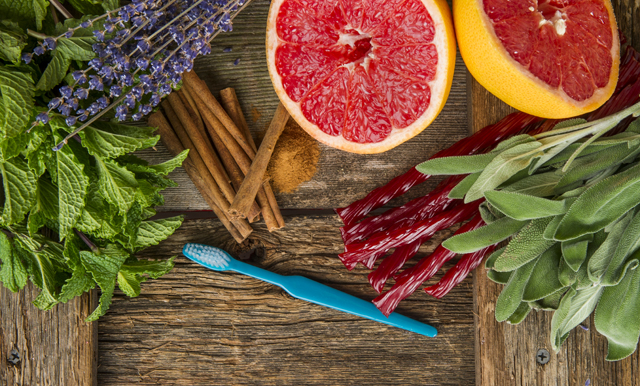Going natural on dental products?

 Thinking of switching to herb and botanical-based oral health care products? Read this first.
Thinking of switching to herb and botanical-based oral health care products? Read this first.
Brushing with toothpaste containing grapefruit seed and licorice root extracts or gargling with a mouthwash derived from cinnamon bark and aloe may sound idyllic, but going natural isn’t necessarily better if you haven’t done your research, say faculty from the Texas A&M University Baylor College of Dentistry’s Caruth School of Dental Hygiene.
“As time goes on, I find I am looking at all natural products more and more,” says Cherri Kading, dental hygiene clinic coordinator and assistant professor, who teaches the school’s health promotion course. “There are a lot of great choices; however, read the ingredients. ‘All natural’ doesn’t always mean ‘good for you.’ Reading labels, using products as directed and asking professionals for help are all important things to remember when looking at these products.”
Lisa Mallonee, associate professor in dental hygiene and a registered dietitian, says she is drawn to all-natural products, but agrees that consumers must do their research.
“Consulting with the dentist may be beneficial if he or she has a working knowledge about the all-natural products,” says Mallonee, who adds that buying through your dentist isn’t a requirement.
There is one gold standard for products organically and chemically derived: the American Dental Association Seal of Acceptance, a program which has been in existence for more than 125 years. If an item is ADA approved, you’ll see the seal on the product or its packaging.
In addition to looking for the time-tested ADA seal, check the item’s ingredients. You want to see essential oils known to pack a powerful antimicrobial punch. Menthol, eucalyptol, thymol and methyl salicylate — wintergreen oil — are commonly used in rinses to freshen breath while preventing gingivitis.
Then there’s echinacea, calendula, sage oil, grapefruit seed and licorice root extracts, and vegetable glycerin, which is made from vegetable oil as opposed to animal fat.
Beware of ingredients such as aloe and goldenseal oil that can act as a double-edged sword.
“Aloe vera is used to promote wound healing,” says Kading, “But it can be associated with diarrhea, kidney dysfunction and a risk for drug interactions.” And goldenseal, while known for its antibacterial and anti-inflammatory properties, is discouraged for pregnant patients.
What about health-conscious parents out there considering all-natural oral health products for their youngsters?
“I think parents have to be even more careful with these products,” says Kading. When in doubt: Seek input from your child’s pediatric dentist and pediatrician, and remember that herbal ingredients need to be monitored.
“Herbal extracts and oils can have side effects and drug interactions if swallowed,” says Kading, “so make sure the child is able to expectorate effectively before using.”
Mallonee adds that the U.S. Food and Drug Administration doesn’t regulate natural products, so any given tube of toothpaste could contain more or less of the stated ingredients, some of which could pose health risks to children.
Whether you’re considering natural oral health products for yourself or family members, it pays to know what is in the product, Mallonee says.
“Be careful of any ingredients that may interact with medications or specific health conditions,” says Mallonee. “Be a label reader.”
Moderation is key when dealing with common all-natural ingredients
 Licorice root extract
Licorice root extract
Purpose: used as a breath freshener and also effective as an antimicrobial, antioxidant and anti-inflammatory agent
Risks: listed as “likely safe” when consumed in food, but consuming 30 grams or more a day for several weeks can lead to medication reactions, low potassium levels, high blood pressure, paralysis and more
Purpose: used as a folk remedy for sore throats and mouth inflammation, it is also said to remove tooth stains and fight bacteria
Risks: The FDA considers small amounts safe. Large amounts of sage leaf or oil can cause restlessness, vomiting, vertigo, kidney damage and more.
Purpose: used to flavor food and products
Risks: considered safe in small doses but can cause allergic reactions and heartburn
Purpose: used to flavor food and products
Risks: Consuming small amounts is safe for most people, but amounts exceeding 6 grams a day for more than six weeks can cause allergic reactions.
Purpose: antibacterial agent
Risks: can reduce the effectiveness of certain prescription drugs within the body or can interfere with digestive enzymes to create dangerously high levels of a particular drug
Purpose: smell and aromatherapy; used to flavor food and products
Risks: It is likely safe in small amounts and possibly safe for medicinal use, but it can cause skin irritation, constipation, headache and increased appetite.
Media contact: media@tamu.edu







